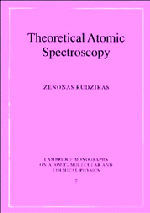Book contents
- Frontmatter
- Contents
- Preface
- Foreword to the Paperback Edition
- Introduction
- Part 1 Energy Spectrum of Many-electron Atom. Radiative and Autoionizing Transitions (Initial Formulas)
- 1 Non-relativistic atomic Hamiltonian and relativistic corrections
- 2 Relativistic atomic Hamiltonian. New wave function
- 3 Perturbation theory for the energy of an atom
- 4 Radiative and autoionizing electronic transitions. Generalized expressions for electric multipole (Ek) transition operators
- Part 2 Foundations of the Angular Momentum Theory. Graphical Methods
- Part 3 Description of Complex Electronic Configurations
- Part 4 Second-quantization in the Theory of an Atom. Quasispin and Isospin
- Part 5 Matrix Elements of the Energy Operator
- Part 6 Electric and Magnetic Multipole Transitions
- Part 7 Calculation of Energy Spectra and Electronic Transitions in the Case of Complex Configurations
- Epilogue
- References
- Index
1 - Non-relativistic atomic Hamiltonian and relativistic corrections
Published online by Cambridge University Press: 21 September 2009
- Frontmatter
- Contents
- Preface
- Foreword to the Paperback Edition
- Introduction
- Part 1 Energy Spectrum of Many-electron Atom. Radiative and Autoionizing Transitions (Initial Formulas)
- 1 Non-relativistic atomic Hamiltonian and relativistic corrections
- 2 Relativistic atomic Hamiltonian. New wave function
- 3 Perturbation theory for the energy of an atom
- 4 Radiative and autoionizing electronic transitions. Generalized expressions for electric multipole (Ek) transition operators
- Part 2 Foundations of the Angular Momentum Theory. Graphical Methods
- Part 3 Description of Complex Electronic Configurations
- Part 4 Second-quantization in the Theory of an Atom. Quasispin and Isospin
- Part 5 Matrix Elements of the Energy Operator
- Part 6 Electric and Magnetic Multipole Transitions
- Part 7 Calculation of Energy Spectra and Electronic Transitions in the Case of Complex Configurations
- Epilogue
- References
- Index
Summary
The word ‘atom’ introduced by Democritus more than 2000 years ago in Greek means ‘unseparable’. Only in the 20th century was it shown by Rutherford that the atom possesses a complex structure. The discovery of the complex inner structure of an atom, in fact, has led to the emergence of the main branch of physics describing the structure of a microworld, i.e. quantum mechanics, which, in its turn, has stimulated the development of many other domains of physics, neighbouring sciences and technology. Quantum mechanics continues to be of great importance for their future progress.
However, it is very far from enough to know that any atom consists of a nucleus and of electrons orbiting around it like planets around the Sun. The inner structure of an atom and its main fundamental characteristic – spectra – hide many fundamental laws of nature, the discovery of which has been a challenge for many generations of scientists. Among these laws it is worth mentioning parity violation and the manifestation of a number of fine quantum electrodynamical effects. This is particularly the case for complex atoms with many electronic shells and for highly ionized atoms, whose shell structure and spectra differ considerably from those of neutral or just a few times ionized atoms. These differences and changes are caused by the interplay of the relative role of existing intra-atomic (electron–nucleus or electron–electron) interactions. Therefore, the ability to describe them precisely in order to take them into account, is very important.
For many reasons atomic spectroscopy continues to be one of the most rapidly developing branches of physics.
- Type
- Chapter
- Information
- Theoretical Atomic Spectroscopy , pp. 3 - 9Publisher: Cambridge University PressPrint publication year: 1997



